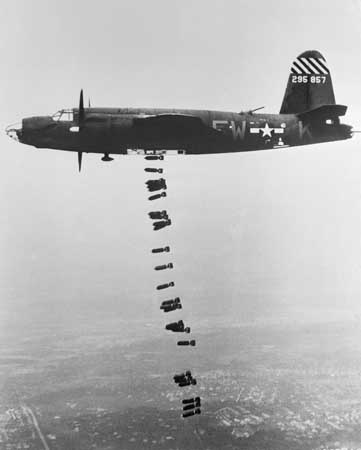B-26
aircraft
also called Marauder
 U.S. medium bomber used during World War II. It was designed by the Glenn L. Martin Company Aviation in response to a January 1939 Army Air Forces requirement calling for a fast heavily-armed medium bomber; the result was an exceptionally clean design with a high wing, a torpedo-shaped fuselage, conventional tail surfaces, and tricycle landing gear. The B-26 first flew in November 1940, and the aircraft entered production “off the drawing board,” there being no prototype as such, in February 1941.
U.S. medium bomber used during World War II. It was designed by the Glenn L. Martin Company Aviation in response to a January 1939 Army Air Forces requirement calling for a fast heavily-armed medium bomber; the result was an exceptionally clean design with a high wing, a torpedo-shaped fuselage, conventional tail surfaces, and tricycle landing gear. The B-26 first flew in November 1940, and the aircraft entered production “off the drawing board,” there being no prototype as such, in February 1941.Powered by two 2,000-horsepower Pratt & Whitney engines, the B-26 had a wingspan of 65 feet (20 metres) and was 56 feet (17 metres) long. It could carry 4,000 pounds (1,800 kg) of bombs internally and had a ceiling of just under 20,000 feet (6,100 metres); its range was approximately 1,100 miles (1,750 km). Early B-26s had a heavy defensive armament for that time, with turrets in the tail and upper rear fuselage mounting twin 0.50-inch (12.7-mm) machine guns. The rear fuselage turret was the first powered turret ever fitted to a U.S. aircraft. Early versions of the bomber were exceptionally fast, with a maximum speed of 315 miles (507 km) per hour. However, the speed came at a price. The short low-drag wings that were responsible for the Marauder's top speed called for takeoff and landing speeds much higher than service aviators were accustomed to. The result was a rash of accidents, so that the B-26 soon acquired a reputation as a “hot” aircraft and was given the nickname “Widowmaker.” The problem was rectified in later versions by fitting longer wings at the sacrifice of some of the Marauder's speed. Later versions also were armed with as many as 12 0.50-inch machine guns.
The B-26 first saw combat in the Southwest Pacific, where it was used in New Guinea from the spring of 1942. However, the Army Air Forces replaced the Marauder with B-25 Mitchells (B-25) in that theatre, and most B-26s served in Europe and the Mediterranean. After a disastrous debut as a low-level bomber in Europe—an entire formation of 10 Marauders was lost to German flak and fighters in a May 1943 attack on targets in The Netherlands—the B-26 was relegated to relatively short-range, medium-altitude operations with heavy fighter escort and served well in that role. Marauders also played a significant role in the Italian campaign and in bombing bridges and rail yards in preparation for the D-Day landings of the Normandy Invasion. They were used in small numbers by Britain's Royal Air Force and by the Free French.
Some 5,000 B-26s were manufactured during the war. Though it was faster than the B-25 and carried a larger bomb load, the B-26 was less well liked by those who flew it. It was dropped from service after the war.
Additional Reading
Roger A. Freeman, Trevor J. Allen, and Bernard Mallon, B-26 Marauder at War (1978, reissued 1991), is a study of the bomber.
- Balfour, Arthur James Balfour, 1st earl of, Viscount Traprain
- Balfour Declaration
- Balfour, Francis Maitland
- Balfour, Robert
- Balfour, Sir James
- Balfour Stewart
- Bal Gangadhar Tilak
- Bali
- Balikpapan
- Balinese
- Balkan Entente
- Balkanization
- Balkan League
- Balkan Mountains
- Balkans
- Balkan Wars
- Balkh
- Balkhash, Lake
- balkline billiards
- ball
- ballad
- ballade
- ballad opera
- ballad revival
- ballad stanza